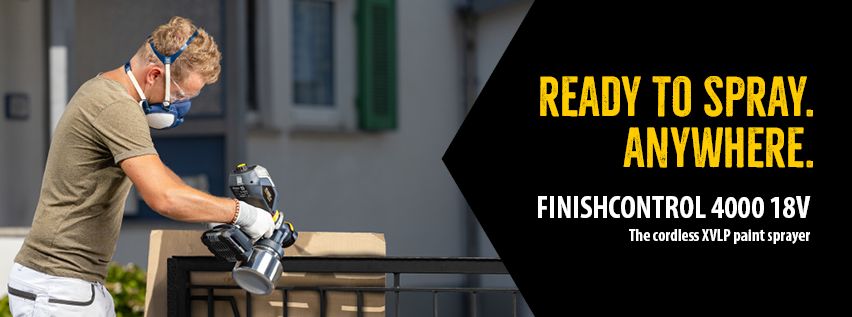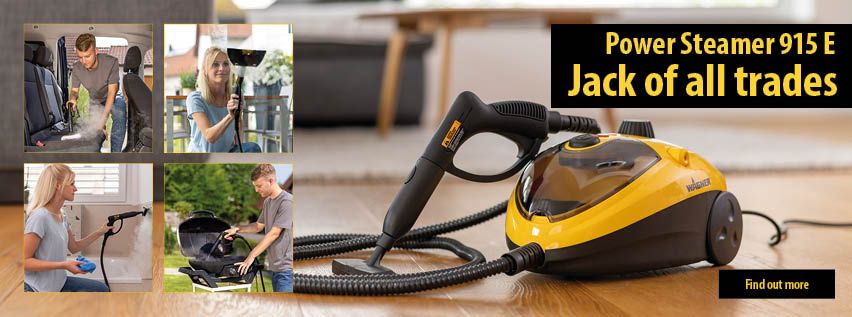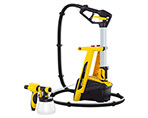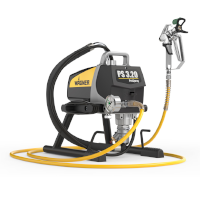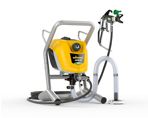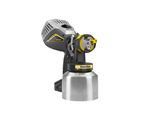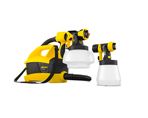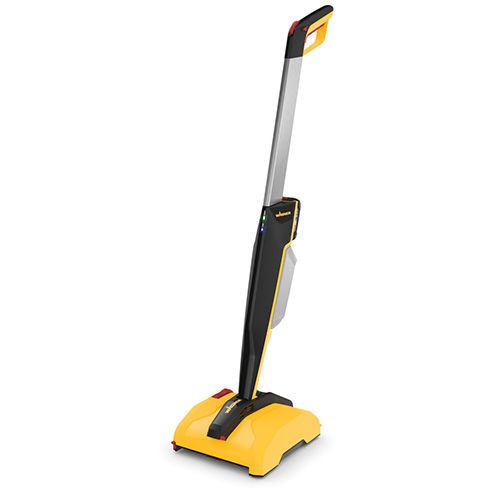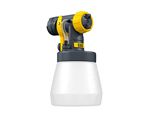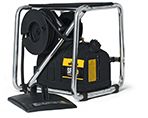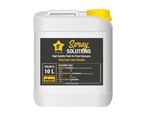Shop by category
Paint sprayer
We have been the online leader in paint spraying for the consumer and professional market in various countries since 2009. We sell, among other things, paint sprayers by Wagner, a German manufacturer considered to be one of the two global market leaders. Wagner has over 60 years experience in paint spraying, and boasts the world's largest technology centre for the development of paint sprayers. All paint sprayers meet the highest ISO standard.
What is a paint sprayer?
A paint sprayer is a product that makes it easy to apply emulsion paint, lacquer or stains. Generally, a paint sprayer has several great advantages over the well-known brush or roller. It can reach those hard to get at places very easily. Think of corners and the transition from wall to ceiling, or behind heating pipes, or wicker baskets or chairs, canopies and shutters, cabinets or fittings. All those spots that a roller either cannot manage at all or only with difficulty. Another major advantage is that a paint sprayer usually gives a far smoother finish than a roller or brush. If you have invested a lot of money on smooth plastering, then it would be a pity to paint over it with a roller.
You are dealing with an electrical appliance, which means starting up takes a bit longer than just dipping a roller in the paint. Nevertheless, a paint sprayer can do the job faster. Once you are busy, you will find the work goes faster and faster. In addition, you won’t suffer physical discomfort. Painting can be a tough job, especially when you are painting above your head. A paint sprayer makes this tough job a lot lighter.
Whenever you paint, you should always tape off or cover floors, and of course that is also the case with a paint sprayer. Although the technology is always developing, paint will always be spilled. As the saying goes, prevention is always better than cure.
There are several versions of the origins of the paint sprayer but it is widely believed that the technique dates back to the late 19th century. Presumably paint sprayers were around when the Southern Pacific Railway was under construction in the United States. The technique was developed to maintain large areas efficiently.
The invention is also attributed to a man called Binks, from Chicago who was asked to paint a huge basement. The area to be painted was so big that the job would have taken weeks if done by hand. According to this version, Binks then invented the paint sprayer. However, this would have happened after than the railway line (1887). All in all, it is safe to say that the technology was born in the US and was widely accepted by the end of the 19th century.
The principle of a paint sprayer has not changed since. Paint is forced under pressure through a small nozzle with the aim of producing a fine and even spray pattern.
Is paint spraying difficult?
After serving thousands of customers in the Netherlands, Belgium, France, Germany and the UK, we can confidently say that anyone can use a paint sprayer and achieve great results. Make sure you dilute the paint, do not exceed a distance of 20 cm between the spray gun and the wall, always keep the spray nozzle perpendicular to the wall, and use masking tape. This will ensure you achieve clean, fast work and a great result.
Can I work with all paint types using a paint sprayer?
Most of them, yes. You can work with water-based or synthetic-based paints. You can also work with almost all types of emulsion paint, stains, lacquers and other paints, as long they are not textured paints (containing solids). However, there are exceptions: exterior emulsion paint can only be sprayed by the Wagner Project 119 and the Wagner HEA Control Pro 350.
What should I take into consideration when buying a paint sprayer?
When purchasing a paint sprayer, you need to answer the following questions:
1. What is the size of my project?
For small projects, we recommend an HVLP paint sprayer, such as the Wagner Wall Sprayer 500, Wood and Metal Sprayer 300, etc. For medium-sized projects, (for example, parts of a house or an entire apartment) we recommend, for example, the Universal Sprayer 950 or the Airless Sprayer Plus. For large-scale projects, we recommend an airless paint sprayer such as the Wagner Project 117 or 119 and the Wagner HEA Control Pro 250 and 350.
2. What kind of objects do I want to spray?
Always consider the largest item that you want to spray in order to determine which paint sprayer is most suitable. Often, a heavy duty paint sprayer can also be suitable for spraying smaller objects. It's much more difficult the other way round!
3. What kind of material do I want to work with? (lacquer, stain, emulsion paint)
Nearly all paint sprayers can be used for lacquer, stain and emulsion paint. Both water-based and synthetic. Exceptions are: light paint sprayers such as the W610 and the W550, for example; these are not suitable for emulsion paint due to the power requirements. All emulsion paint sprayers are (or can be made) suitable to a greater or lesser extent for spraying lacquer/stain.
4. Do I also want to spray exterior emulsion paint?
You can only use the HEA Control Pro 350 and the Project 119 for exterior emulsion paint jobs.
Should you still have further questions, please don’t hesitate to send us an email, or call us; we will be happy to provide you with assistance.
Does a paint sprayer produce mist (overspray)?
A paint sprayer always produces some overspray! However, it is highly manageable if you follow the following rules:
- Always read the manual.
- Read the instructions for the paint.
- Hold the nozzle no further than 20 cm away from the wall.
- Do not swing, but aim the spray head perpendicular to the wall.
- Always mask or tape off areas that should not be sprayed.
- If you follow these rules, overspray is very manageable.
How much time does it take to clean a paint sprayer?
A HVLP device will take about 15 minutes to clean. An Airless sprayer requires 20-30 minutes to clean properly.
Is it hard to use a paint sprayer?
Spray painting is a proven technique. Many consumers and professionals have used it to achieve wonderful and satisfying results. You don’t need to be technically skilled. But we do recommend that you read the manual.
Does paint spraying give nice results?
In one word: absolutely! If you follow the recommended steps, you will get a very good result compared to the roller or brush.
Which paint sprayer should I buy?
This question is not difficult to answer, because of some small differences between the different paint sprayers. However, we need to know a little about you paint job. We normally look at the size and also the things that need to be painted. For instance a or some walls, can easily be done with a HVLP sprayer with high power (630W) : W890 and W690 or maybe the W500.
For smaller things like furniture, closets or bikes, the W590 is sufficient for the job.
If you would like re-paint your complete house (walls and ceilings), but don't have the budget for Airless, we would rather advice the W950
When you prefer Airless quality, for instance when your home was just plastered, and jou want to keep this sleek result. Consider the Project Pro 117 or PowerPainter 60 for a complete house. The Project Pro 119 and HEA Control Pro 350 can also be used for even bigger projects, but also when more comfort is prefered.
Is working with a paint sprayer really quicker?
Yes it is! For example:
- A wicker chair
- Paint sprayer: about 25 minutes
- Brush: about 50 minutes
- A dresser
- Paint sprayer: about 25 minutes
- Brush: about 85 minutes
- Window shutters
- Paint sprayer: about 10 minutes
- Brush: about 70 minutes
- A room 16m2
- Paint sprayer: about 15 minutes
- Brush: about 58 minutes
You can see that research show that the actual spay time is a lot quicker, than doing the same project with a brush. However these lead times are without preparations and cleaning. And this is a lot quicker with a brush. The biggest difference is the result that you will achieve.

